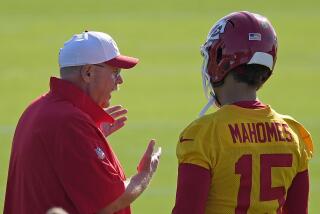New Money May Lessen Nomadic Tendencies
SAN DIEGO â Neil Smith pushed his foot down on the accelerator even though he had no idea where he was going.
All he knew was that he wanted to get out of Kansas City.
Fast.
For nine years, Smith had been a defensive lineman for the Kansas City Chiefs, appearing in five Pro Bowls and recording 86 1/2 sacks while starting 127 of the 138 games in which he had played.
Then it all ended, just like that. Kansas City Coach Marty Schottenheimer informed Smith after the 1996 season that Smith would have to gauge the value of his free-agency status elsewhere because the Chiefs no longer were interested in him.
âMarty told me that they wanted to go with youth,â the 31-year-old Smith said.
The news was stunning to Smith because he was more than just a mercenary who happened to wear the red and white colors of the Chiefs. He had sunk his roots so deeply into the community on so many levels that he had won the âSuper Kansas Citian Award.â
Smithâs imminent departure devastated him.
âIt was overwhelming,â he said. âItâs something over which tears were shed. Iâm not afraid to say I cried.
âI tried to help put that city on the map. I left a lot of friends and a lot of other things.â
After having a good cry, Smith got in his car and started driving. He wound up in Lincoln, Neb., three hours later although the destination wasnât important. Just the journey.
âI needed to inhale and exhale,â he explained, âand just get it out. By the time I got back home, I felt better about myself.â
So imagine how he feels now.
Smith found in Denver Bronco Coach Mike Shanahan all that he couldnât get from Schottenheimer, on the field and in his bank account. Smith signed a one-year contract for $1.5 million with an additional $1 million in incentive bonuses, which he already has earned.
He got 8 1/2 sacks for Denver in 14 regular-season games and helped his team dispose of three postseason opponents, including Schottenheimerâs Chiefs, enabling the Broncos to drive all the way to Sundayâs Super Bowl, where theyâll face the Green Bay Packers.
Thatâs a much better drive than the one Smith took after getting the supposedly bad news from Schottenheimer.
But Smith, again a free agent after Sunday, wonât say if he plans to return to Denver next season, or try to return to Kansas City, or look elsewhere.
âIâll worry about it after Sunday,â he said. âRight now, Iâm happy to be where Iâm at.â
Where heâs at is in a spot as one of those rare players whose specialized skills were a perfect fit for an otherwise talented team with a hole to fill. The result was a perfect marriage with a Super Bowl honeymoon.
Others who have reached the Super Bowl in their first year with a new team include Deion Sanders (twice, with the San Francisco 49ers and Dallas Cowboys) and Desmond Howard (last year with the Packers).
Will this trend continue as Americaâs most popular sport heads into a new millennium?
Perhaps not.
Itâs not that clubs wonât have the money to try to buy a trip to the Super Bowl, not with the NFL approving a new television deal Thursday that will pay it $17.6 billion over the next eight years.
But many owners seem to think the new money, which will increase each teamâs salary cap from $41.45 million this past season to somewhere between $53 and $55 million next season, will be used largely to keep the best players they have.
That will be good news to those who feared that football, once the contracts of the many players currently tied up to long-term deals expired, was going to careen wildly out of control in the direction of major league baseball, where the idea of renting players for a year to try to buy a pennant has become all too commonplace.
The reason so many star NFL players have been up for bidding in the past is simple caponomics. Most teams are always juggling their needs and their personnel while skirting the edge of the cap limit.
âMy first agenda,â Baltimore Raven owner Art Modell said after approving the new television deal, âwill be to keep what I want to have before I look elsewhere.â
The agenda of New England Patriot owner Bob Kraft sounds much the same.
âWe have one of the highest ratios of drafted players to players still remaining on our roster in the league,â Kraft said. âWe hope this nwill allow us to continue to build through our system and keep the players we have.â
Thatâs great news for a team like the Cowboys, who had gambled by making huge contract commitments that depended on the cap going up radically.
âPrior to the signing of these television contracts,â agent Leigh Steinberg said, âthere was gloom and doom over the wasteful spending habits of teams that could have been paralyzed by the cap. Now that gloom and doom wonât come true. Those teams bet right. There are enough dollars so that the bottom wonât fall out. The cap wonât have the effect of dismantling teams. The harsh effects on a Dallas Cowboys wonât be there. They will be able to retain a much larger number of their veterans. You wonât have the divorces of the past because of caponomics.â
Of course there will always be a hole to fill here and there. And, with the new money available, the price of replenishing talent, either on a team merely a player short of being a contender or on a true fixer-upper, just went up.
Dramatically.
âYou will see some explosive new contracts at four positions,â Steinberg said, âthose who have benefited most from the way football has been played in â90s--quarterback, offensive lineman, defensive tackle and cornerback. You will see the salary levels at those positions soar.
âA Steve Young currently has the highest single-season package at $7 1/2 million. Soon you will see a $10-million-a-year player, and then $12 million.â
So if you see Neil Smith driving down the highway in the coming off-season, itâs pretty safe to assume where heâs headed this time.
Straight to the bank.
More to Read
Go beyond the scoreboard
Get the latest on L.A.'s teams in the daily Sports Report newsletter.
You may occasionally receive promotional content from the Los Angeles Times.










